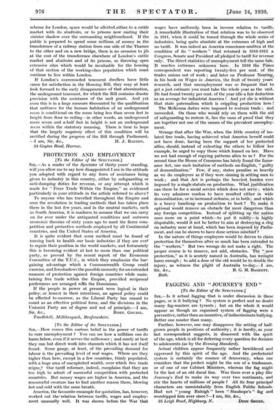THE HOUSING BILL AND ITS APPLICATION TO LONDON
[To the Editor of the SPECTATOR.] Sm,—In his book, How to Abolish the Slums, Mr. E. D. Simon points out that the London slum problem is admittedly far more difficult of solution than that of the other great cities, so much so, that it is a special problem requiring special separate consideration. Mr. Simon does not go on to offer a solution to this special problem, regarding it perhaps as so immense that it would require disproportionate space in a book dealing with the national problem as a whole.
In these circumstances it is hardly a matter for surprise that the new Housing Bill, presenting a national scheme for the abolition of slums, fails to cover the special case of the London slums. Although London contains various unhealthy areas falling within the definition of clearance or improvement areas, where demolition or partial demolition is to take place, and where the displaced population will come in for the benefits of the new unit grant, the main problem is the pro- vision of adequate housing conditions for an overcrowded population numbering nearly 700,000 according to the last Census, and mostly occupying tenements in structurally undivided houses which were originally designed for the occupation of one family and have not been adapted, or not adequately adapted, for tenement purposes. Such houses being for the most part in a fair or moderate state of repair, the bulk of their population are not to be helped by the unit grant and are only eligible for the lesser relief afforded by the Wheatley Act.
Here we come on another feature of the special London problem in the distance of the new housing estates in Outer London from the places where the wage- earners work, and the high travelling expenses involved. But, even so, the present demand for working-class accommodation in the new estates vastly exceeds the supply. This is proved in the L.C.C. housing statistics for 1928-9, which show 150,000 applications and enquiries in the year for housing accommoda- tion as against 35,000 dwellings completed under the successive Housing Acts since the War. One can go on to say that the additional houses built during this period by the L.C.C. as well as by other authorities and agencies have to date certainly made no noticeable impression on the housing shortage in the overcrowded areas. Even for slum dwellers who can afford the rent of a council house and the additional travelling expenses the prospects of the allotment of a council house seldom go beyond registration in waiting lists of such length as to reduce the applicants to hopelessness.
The still larger proportion of slum dwellers who, though they can afford the rent of a council dwelling, are unable to face the loss of time and money spent in travelling, can only live in hope that the operations of the promised town planning Bill will in some distant day bring relief, if not to themselves, at least to another generation. But in this connexion may it not be thought that the time has come for the governing authorities to consider town-planning possibilities falling within their own scope and competence—in other words, to weigh in the balance the sites of any public institutions for which location in London is not essential, and which would function just as well, if not better, outside London ? It is, for instance, hard to believe that the precinct of London is ideal for the sale and slaughter of cattle. And there is good reason to doubt whether, in a modern town-planning scheme for London, space would be allotted. either_to a cattle market with its abattoirs, or to prisons now casting their sinister shadow over the surrounding neighbourhood. If the public is prepared to spend some. millions. of money in ,the transference of a railway station from one side of the Thames to the other and on a new bridge, there is no occasion to jib at the cost of the transference elsewhere of London's cattle market and abattoirs and of its prisons, so throwing open extensive sites which would be invaluable for the housing of that section of the working-class population which must continue to live within London.
If London's overcrowded tenement dwellers have little cause for satisfaction in the Housing Bill, they may at least ,look forward to the early disappearance of that abomination, the underground tenement, for which the Bill contains drastic provision with the assistance of the unit grant. And yet even this is in a large measure discounted by the qualification that unfitness for the human habitation of an underground room is conditional on the room being less than seven feet in height from floor to ceiling—in other words, an underground room seven and a-half feet in height is not an underground room within the statutory meaning. There is time to hope that the largely nugatory effect of this condition will be rectified during the progress of the Bill through Parliament.



































 Previous page
Previous page